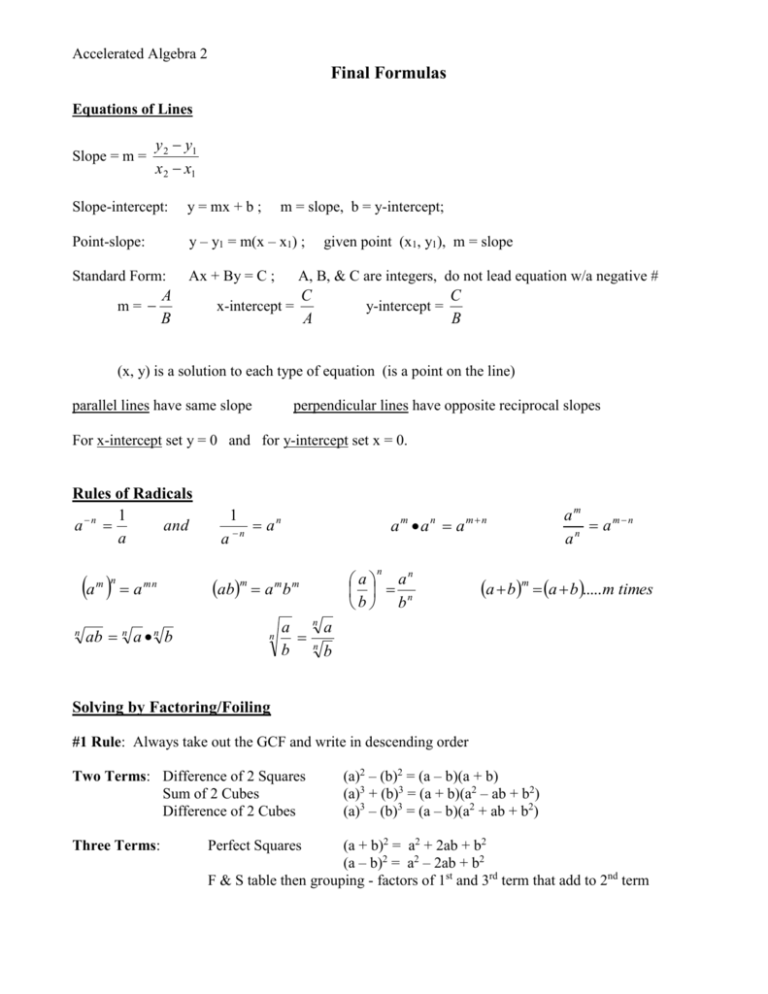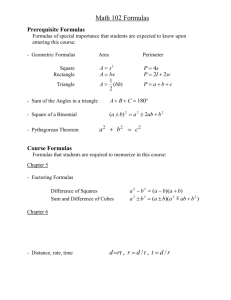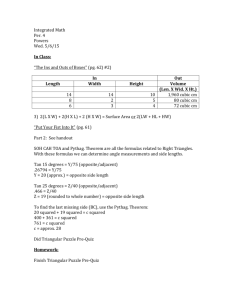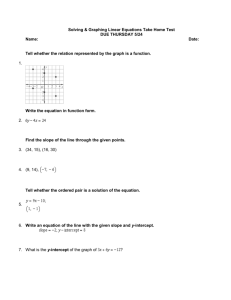Algebra 2 Final Exam Formulas Sheet
advertisement

Accelerated Algebra 2 Final Formulas Equations of Lines Slope = m = y 2 y1 x 2 x1 Slope-intercept: y = mx + b ; Point-slope: y – y1 = m(x – x1) ; Standard Form: Ax + By = C ; A m= B m = slope, b = y-intercept; given point (x1, y1), m = slope A, B, & C are integers, do not lead equation w/a negative # x-intercept = C A y-intercept = C B (x, y) is a solution to each type of equation (is a point on the line) parallel lines have same slope perpendicular lines have opposite reciprocal slopes For x-intercept set y = 0 and for y-intercept set x = 0. Rules of Radicals 1 an and a a m n n a mn ab a b n n 1 a n ab m am an amn an n n a a n b b a b m m n a b n n am amn n a a bm a b.....m times a b Solving by Factoring/Foiling #1 Rule: Always take out the GCF and write in descending order Two Terms: Difference of 2 Squares Sum of 2 Cubes Difference of 2 Cubes Three Terms: (a)2 – (b)2 = (a – b)(a + b) (a)3 + (b)3 = (a + b)(a2 – ab + b2) (a)3 – (b)3 = (a – b)(a2 + ab + b2) (a + b)2 = a2 + 2ab + b2 (a – b)2 = a2 – 2ab + b2 F & S table then grouping - factors of 1st and 3rd term that add to 2nd term Perfect Squares Accelerated Algebra 2 Final Formulas 4x3 + 10x2 – 6x → 2x(2x2 + 5x – 3) → Short cut: 2x 2 2x 2 , x 6x 2x x , 1 3 2x(2x – 1)(x + 3) Four Terms: Grouping method If cannot factor, Complete the Square or Quadratic Formula Completing the square: 0 = 2x2 + 4x – 8 , 8 + 2 = 2(x2 + 2x + 1) , 10 = 2(x + 1)2 5 = (x + 1)2 5 =x+1 –1 5 = x Quadratic Formula: x= b b 2 4ac 2a Discriminant: b2 – 4ac >0 two real roots, = 0 1 real root, <0 2 imaginary roots (nature of the roots, # of x-intercepts) Writing Equations of Quadratics Sum and Product of the roots: Conic Sections 0 = ax2 – (sum)x + product a, b, c must be integers s1+s2 = sum s1·s2 = product a=1 Vertex: x or y = b 2a y = ax2 + bx + c / y = a(x – h)2 + k x = ay2 + by + c / x = a(y – k)2 + h (x – h)2 + (y – k)2 = r2 Parabola - 1 squared term Circle – 2 squared terms same coefficient Ellipse – 2 squared terms, different positive coefficients Hyperbola – 2 squared terms, 1 positive, 1 negative x h 2 y k 2 1 a 2 or b 2 x h 2 a 2 or b 2 Distance/Midpoint Formulas d= x2 x1 2 y2 y1 2 Midpoint (xm,ym) xm = x1 x2 2 ym = y1 y 2 2 a 2 or b 2 y k 2 1 a 2 or b 2 V(h, k) V(h, k) C(h, k) V(h, k) V(h, k) Accelerated Algebra 2 Final Formulas Logarithms log b a = n → bn = a a > 0, b > 0, b ≠ 1 log b a = log b c then a = c log b a + log b c = log b ac log b a – log b c = log b a c nlog b a = log b an log b 1 = 0 log b b = 1 log b a = b log b a log c a log c b a ln x = log e x a) b) c) ln 1 = 0 ln e = 1 e ln a = a Sequences Arithmetic sequence: tn = t1 +(n – 1)d d = common difference Geometric sequence: t n t1 r n 1 r = common ratio Permutations Arrangements; order matters n Pr n! (n r )! Combinations Order does NOT matter (thinks groups) n Cr n! r!(n r )! Accelerated Algebra 2 Final Formulas Direct Variation: y kx *k is the constant of variation Solve for k first and then answer question Inverse Variation: y k *k is the constant of variation x How to find zeros of a function: Set the equation equal to zero and solve! How to find domain of a function: Think x, check the restrictions of the function f ( x) x4 Domain: all reals except -2 x2











